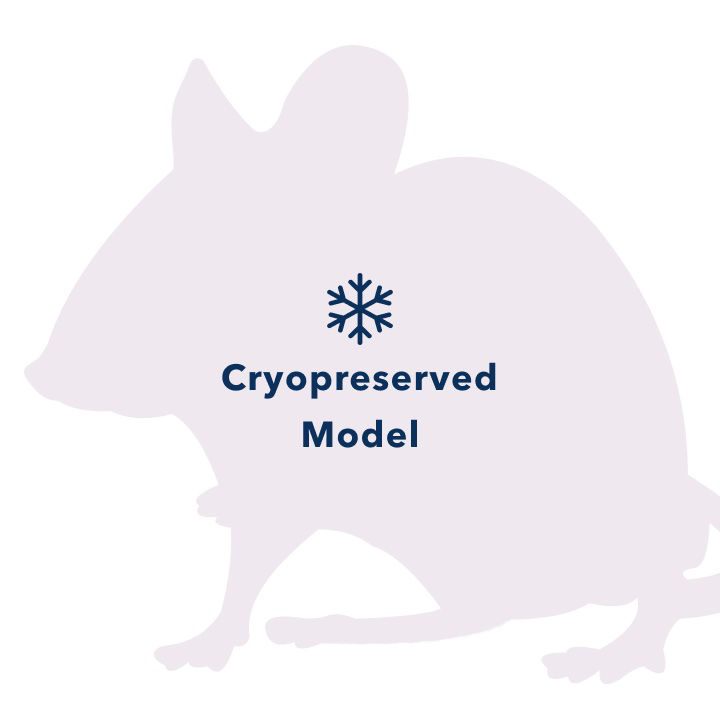| Model No. | Nomenclature | Genotype |
|---|---|---|
| 11512 | B6.129P2-Trp53tm2Brn/A | Inquire for genotype |
Floxed p53 Mouse

- Description
- Price & Licensing
- Overview
- Genetics
- Guides & Publications
- Applications & Therapeutic Areas
- Transit, Housing & Welfare
- Diet
Overview
Nomenclature: B6.129P2-Trp53tm2Brn/A
- Contains a targeted mutation of Trp53 which introduced LoxP sites flanking exons 2 through 10.
- Cross with the tissue-specific Cre of your choice to generate a conditional disruption of the Trp53 tumor suppressor gene, the most commonly mutated gene in human cancers.
- Useful for studying Trp53 gene function or screening potential cancer intervention therapies.
- Conditional mutation avoids the predominance of non-epithelial tumors observed in constitutive Trp53 knockouts.
- After deletion of the gene via crossing to a tissue-specific Cre line, the incidence and the spectrum of tumors observed in homozygous or heterozygous mutant animals were comparable to those found in constitutive knockouts.
Origin
This model is cryopreserved and available for recovery. Models can typically be recovered and delivered to customers within 12 weeks after order receipt. Purchase of this model includes perpetual use rights and a deliverable of four mutant animals at the Murine Pathogen Free™ health standard along with a genotyping protocol. For models which include a recombinase gene or multiple alleles, all alleles will be provided, but individual animals may not contain all mutant alleles.
Taconic’s Colony Management experts can design a plan to grow your colony faster.
Genetics
Guides & Publications
Initial Publication: Jonkers J, Meuwissen R, van der Gulden H, Peterse H, van der Valk M, Berns A. (2001) Synergistic tumor suppressor activity of BRCA2 and p53 in a conditional mouse model for breast cancer. Nat Genet. 29(4):418-25.
Applications & Therapeutic Areas
- Oncology & Immuno-Oncology
Transit, Housing & Welfare
Need more info? Click the live chat button or Contact Us
Diet
- Licensing
- Pricing - USD
- Pricing - EUR
- Pricing - DKK
- Select my Health Standard
- Get Custom Pricing Guide
Floxed p53 Mouse
This model is sold under terms which grant perpetual use rights.
Pricing - USD
11512-EZcohort-4
| Item | Commercial | Nonprofit |
|---|---|---|
| Cryopreserved Model | US$23,100.00 | US$17,325.00 |
Cryopreserved models are invoiced upon shipment of recovered animals. Once orders are placed, the full purchase price will be applied if the order is canceled. For orders greater than 4 animals, please contact Taconic for options.
Fees for Taconic Transit Cages™ and freight are in addition to the price above.
Pricing - EUR
11512-EZcohort-4
| Item | Commercial | Nonprofit |
|---|---|---|
| Cryopreserved Model | 21.000,00 € | 15.855,00 € |
Cryopreserved models are invoiced upon shipment of recovered animals. Once orders are placed, the full purchase price will be applied if the order is canceled. For orders greater than 4 animals, please contact Taconic for options.
Fees for Taconic Transit Cages™ and freight are in addition to the price above.
Pricing - DKK
11512-EZcohort-4
| Item | Commercial | Nonprofit |
|---|---|---|
| Cryopreserved Model | kr.156.660,00 | kr.118.278,30 |
Cryopreserved models are invoiced upon shipment of recovered animals. Once orders are placed, the full purchase price will be applied if the order is canceled. For orders greater than 4 animals, please contact Taconic for options.
Fees for Taconic Transit Cages™ and freight are in addition to the price above.
Select my Health Standard
Need help choosing the right Taconic Biosciences health standard for your research?
Use the Health Standard Selector to enter your exclusion list. The tool will tell you which health standards meet your requirements.
Get custom pricing guide
Schedule A Scientific Consultation
Connect directly with a member of our Scientific Solutions team who can help you select the most appropriate model and maximize your experimental success.
















.jpg)

.jpg)
.jpg)
.jpg)
.jpg)





.jpg)


.jpg)
.jpg)




.jpg)




.jpg)

.jpg)




